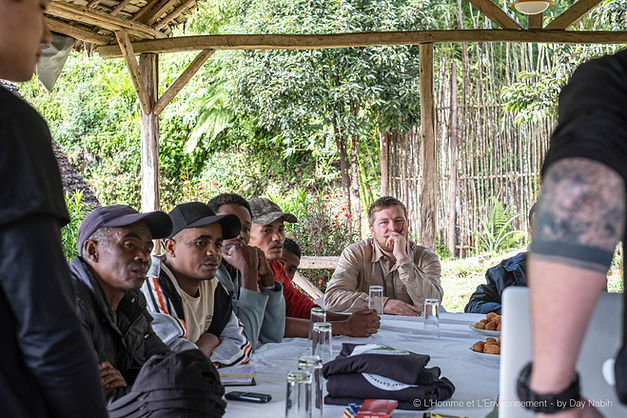
Conservation
"Excellence is not the result of an isolated impulse, but of a succession of small elements that come together"
Vincent van Gogh
Integrated conservation for chameleons: understanding, protecting, transmitting
The conservation of chameleons is part of a wider effort to preserve biodiversity. These reptiles, often endemic to specific forest environments, are particularly sensitive to the degradation of their habitat and the fragmentation of ecosystems.
The strategy advocated by Caméléon Center Conservation is based on an integrated approach, combining in situ and ex situ actions, in synergy with scientific partners, natural area managers and zoological institutions. Inspired by IUCN guidelines, this approach aims to mobilise all available levers from the earliest stages of a conservation project.

Chameleon inventory, Vohimana reserve (Madagascar)
Protecting chameleons in their natural habitat: the need for in situ conservation
In situ conservation remains the fundamental pillar of chameleon preservation. It ensures that species are preserved in their natural ecosystem, with all the ecological interactions that determine their survival: microclimate, vegetation, food resources, competitors and predators.
Chameleon Center Conservation carries out actions in partner nature reserves, in forest ecosystems that are home to a rich diversity of chameleons. Projects include:
-
field inventories to document the distribution and diversity of species;
-
long-term ecological monitoring to better understand their population dynamics;
-
behavioural and physiological studies in their natural habitat;
-
concrete actions to preserve critical microhabitats.
These actions are carried out in close collaboration with local stakeholders, researchers and protected area managers, in an approach that encourages local ownership of conservation issues.

Conservation breeding Calumma parsonii (MUZOO, Switzerland)
Taking action outside the natural environment: ex situ conservation as a complementary tool
When the pressures on habitats become critical - deforestation, climate change, genetic isolation - ex situ conservation makes it possible to temporarily protect certain species outside their natural environment.
Means of action include:
-
conservation breeding to preserve genetically viable populations;
-
structured breeding programmes between zoological institutions;
-
the creation of gene banks or biological collections;
-
applied studies into the reproduction, health or ecology of target species.
Chameleon Center Conservation contributes to these efforts through rational breeding, scientific analysis and international collaboration. These actions help to maintain essential genetic diversity, while building bridges towards future actions to reinforce or reintroduce species into the wild.

Raising awareness among guides and researchers (Madagascar)
Informing and involving: raising awareness as a lever for action
Conservation also requires a better understanding of the issues by the general public and local communities. Without social support, even the most ambitious strategies are doomed to failure.
Chameleon Center Conservation is committed to raising awareness of chameleon conservation, both in the areas where these reptiles live and in the countries that host captive populations or fund field actions. These initiatives take the form of:
-
educational events in communities bordering tropical forests;
-
scientific outreach activities in zoological institutions;
-
training courses for professionals in the animal sector and biology students;
-
the distribution of popularisation tools (posters, videos, exhibitions, articles) to reach a variety of audiences.
Each awareness-raising initiative aims to strengthen the link between man and biodiversity, encourage shared responsibility, and build a conservation culture based on knowledge, wonder and commitment.
Bibliography:
-
IUCN/SSC 2014. Guidelines on the Use of Ex Situ Management for Species Conservation. Version 2.0. Gland, Switzerland: IUCN Species Survival Commission.
-
UICN 2020. CPSG Species Conservation Planning Principles & Steps,Ver. 1.0. Groupe de spécialistes de la planification de la conservation de l’UICN CSE : Apple Valley, MN.
-
UICN 2022. Comment la planification de la conservation peut vous aider à atteindre vos objectifs de conservation des espèces. Conservation Planning Specialist Group (CPSG) http://cpsg.org/content/get-know-cpsg-french
-
Construire un avenir pour la faune et la flore. La Stratégie Mondiale de Conservation des Zoos et Aquariums. WAZA
-
WWF 2007. Policy Statement on Captive Breeding
-
Ziegler et al. 2022. Threatened Malagasy amphibians and reptiles in zoos – a call for enhanced implementation of th IUCN’s One Plan Approach. Zool. Garten N.F. 90: 21-69.




